Who are the Kosraeans?
What makes a place what it is? It’s not the scenery, the buildings, the history, the food or the tourist attractions, It’s the people. The people who live in a place make the place what it is.
Although I’m thousands of miles from friends and family, I’m not lonely on Kosrae because this is a very hospitable place. It’s easy to meet people and make new friends here. There are about 6,000 people living in Kosrae. Allow me introduce you to a few of them.
Ken Charley (47) lives a 5-minute walk down the road from my apartment. Although Ken was born and raised on Kosrae, he’s seen a lot of the world. He joined the US Army in 1996 and was deployed to Bosnia and Kosovo during the Balkan Wars. Later, he had three tours to Iraq, two tours to Afghanistan and one tour to South Korea. After 20 years in the Army, Ken retired and returned home to Kosrae with his wife and five children. (Two of his children were born in Alaska, one in Colorado, and one in Washington.) Ken now serves as a lay minister at the Baptist church. When I attended his service recently, he did a simultaneous translation of his sermon in English — just for me.
This is Alokoa Talley (74). He’s very knowledgeable about Kosrae. He graduated from Kosrae’s historic Mwot School in 1965. This school was founded by American missionaries in 1879 to teach English, Math, Geography, Music and Bible studies to children from Micronesia and nearby islands. Alokoa has two sons in the US Army. He visited one of his sons in the US once. He came back to Kosrae after a week and has no intention of returning to the US. He works as a guide and taxi driver shuttling passengers back and forth on Kosrae’s one paved road. He often gives me rides back from town when I have lots of groceries.
Kenye George (25) was one of the first people I met in Kosrae because she worked at the College of Micronesia (COM). In March, when I was enquiring about a volunteer position with the school, Kenye gave me a tour of the campus and introduced me to the Dean and the faculty. As a high school junior, she was one of six students who won a two-week trip to Washington DC. The following year, she was the valedictorian of her high school class. She earned an Associates degree at the COM and continues her studies on-line at Chaminade University in Hawaii. Her son recently had his first birthday. In Kosraean tradition, first birthdays are big events. I attended the party — along with what seemed to be about half the island’s population.
Like many Kosraeans, Jack Sigrah (62) is descended from royalty. His great-grandfather was the last king of Kosrae. Jack is also part German because one of his grandmothers married a German administrator posted here before World War I. Like many Kosraens, Jack has a big family. He has four sons and three daughters. He can’t remember how many children his seven uncles and seven aunts have. Jack visited one of his nephews in Los Angles once. He didn’t like the US and has no plans to return..
Kenye works with Maureen (whom I’ve mentioned in previous posts) at the United Airlines service counter at Kosrae’s airport. Kenye and Maureen keep me informed about commercial flights to Kosrae. The latest news is that United plans to resume its island hopper service, albeit on a limited and restricted schedule. Starting in November, there will be two flights per month. These flights are intended for people who wish to leave Kosrae. To prevent Covid-19 coming to Kosrae, no one will be allowed to deplane, not even the flight crew. Although I have no plans to leave Kosrae soon, it’s reassuring to know that if I had a medical emergency or a family crisis back home, I could leave Kosrae if I had to.
Kerick Benjamin (69) is a retired construction engineer, trained in operating heavy equipment by the US Army Corps of Engineers. Kerick’s crews built Kosrae’s airport and paved Kosrae’s road. Kerick also worked for Kosrae’s Historic Preservation Office for 24 years recording many of the oral histories of Kosrae. Kerick and his wife Caroline have 14 grandchildren. One of their daughters lives in Branson, MO. Kerick and Caroline have been to Branson four times and look forward to their next visit after travel restrictions are lifted.
In 1900, Kosrae’s population was less than 300 due to diseases introduced by Europeans, Thanks to a high birth rate, Kosrae has rebuilt its population to precolonial days. Gasma Nedlic and his wife have six children. Gasma’s unusual last name is a contraction of the family name of his great-grandfather Pierre Nedhelić, who came to Micronesia a century ago from Croatia. When Gasma visited Croatia to research his family roots, he was greeted enthusiastically in the hometown of his great-grandfather. The Croatians were amazed to meet a Pacific Islander with their last name.
Kosrae has one high school, serving about 400 students. Here are some of my students studying rocks and minerals. In June, their high school was converted into a Covid-19 quarantine facility. Although no one has come to Kosrae since March, the high school is a restricted area and cannot be used. So, the school has divided itself into five districts. The students — and the teachers — get the benefit of small classes. I teach Algebra II and Earth Science to 16 Seniors and Geometry and Chemistry to 14 juniors.
The school is a mile from my apartment. Here’s a photo I took while walking to school last week.

Although people are what make a place what it is, food is important to me — especially if I plan to stay someplace for a while. Sadly, Pacific islanders are famous for their unhealthy diet of Spam, rice and soda. The ten most obese countries in the world are all Pacific Island nations. (The U.S. is #12 on this list!)
The good news is that Covid-19 has forced Kosraeans to reduce their dependence on foreign imports and to grow their own food. Enterprising Kosraeans have planted gardens. They sell their produce at shacks along the road. Below is a photo of what I picked up last Monday on my weekly grocery run. It’s all locally grown and organic. The papayas and bananas are perfectly sweet. The eggplants and squash are firm and tasty. Although I’m not a big fan of okra, I bought some anyway because it was cheap. The total cost for what you see here was $11.50. With plenty of fresh fruits, veggies and fish, I think I can live here for a while.
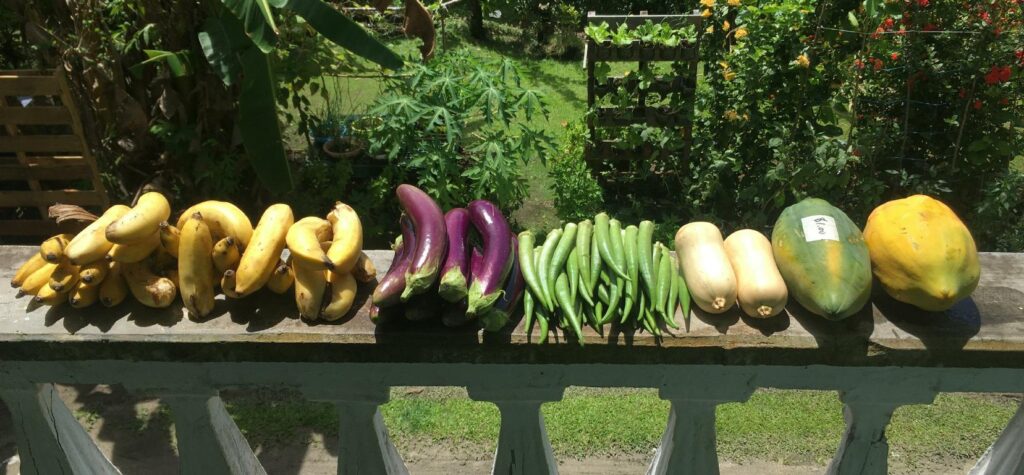
In other news, a repatriated student brought Covid-19 to the Solomon Islands last week. Although the student tested negative three times before getting on the plane to Honaria, he tested positive a couple days after he arrived in the Solomons. The Solomons now have three Covid-19 infections. This sort of news will make the few islands that remain Covid-free even more cautious about allowing anyone to come here. Everyone in Kosrae feels lucky to be here — including me.
Thanks to the US mail, I voted absentee earlier this month. Let’s all pray for a peaceful outcome to the election on November 3rd. Please vote for the side that respects science and the rule of law.


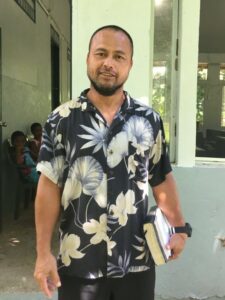


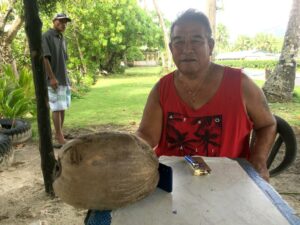
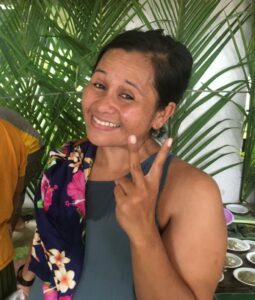
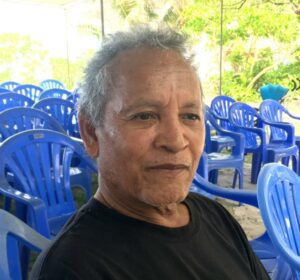

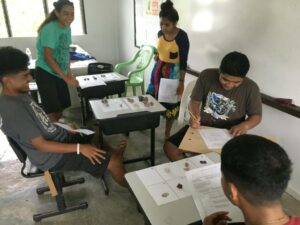
Hi Nick,
I’m enjoying reading your latest post with my coffee early this morning. Thank you for profiling some of the Kosraeans; it was surprising to me to read of the many connections with the US military, especially that of Ken Charley … wow!!! I’ve also been to LA once, and if that had been my first impression of the US, I would never have wanted to go back either!
I see some beautiful red and yellow flowers in the background of your vegetable photo. Is the island just filled with flowers? It’s obviously very lush as one would expect.
My father was a dive bomber pilot in the So Pacific in WWII, primarily around the Solomons, and I have his photo scrapbook and pilot log books … fascinating as I know what his targets and flights were on, say, April 19, 1943. He brought home three hand-carved war clubs from the Solomons, and I have one hanging in my living room.
He had a wonderful story. Every day when he landed on a primitive airstrip carved out of the jungle, there was an elderly man waiting and watching. Although it was strictly forbidden, my dad finally asked (with sign language) if he would like to go up in the plane. My father loved to fly, and he performed every loop and twist he knew how to do, looking back to see the man grinning from ear to ear! When they landed, the man signaled for him to wait and ran off. When he returned, he had a filthy little bag tied with string; inside were roughly 20 cat’s eyes, collected by the man over a lifetime of diving in the reefs. My father brought them home and kept them on his dresser in a little dish … my sister and I played with them, and after my father’s death in 1980, my mother had many of them turned into bracelets for us. I never wear it that I don’t think of that man waiting in the jungle for the plane to land; he must have thought flying was pure magic! How else could he have explained it? Surely he had never seen a plane before the war, much less a white man. I’ve often wondered if it has been a story passed down on the island.
I was to have gone to Hawaii in June to climb five volcanoes, which was of course cancelled. That trip has been replaced by Alaska in June, where we will be flown into Denali and dropped on the glacier to hike. I have my fingers crossed that it will happen. Then I’m off to the Grand Tetons in Sept., Republic of Georgia in Oct., and India in November. I think the last two are looking doubtful but hopefully those in the US will occur.
I think more than 50% of the US population would give their right arms to be where you are, given the current level of hysteria here, both with Covid and the election. It’s impossible to grasp that more than 40% of the people here support such an obvious grifter. On verra …
Take care and I will look forward to your next post from Kosrae!
Sally
Sally, when we travel it is critically important to be particularly cautious in confined spaces (airplane) close to others,
Your face covering will not protect you unless it is a N or P 99 or100. A bandanna or surgical mask will not protect you from other’s infections. It will stop blobs of liquid but individual Virus particles easily pass through most masks. 6 feet distance is not adequate when someone sneezes. 30 feet (in still air) is much closer to what is needed. A respirator fits faces better and has valves making breathing easier but they do not protect others as the outlet valve is normally unfiltered.
Hi Sally,
My wife Trish and I have been fortunate to join Nick on some of our travels over the past ten years, and like you, we look forward to his tales. The reason I am responding to your comments is because I would like to compliment you on your writing. I am far from a grammarian but know enough to admire a well written sentence—and you have stung together many.
Also, I calculate from our comment about your father, a WWII vet, you are a similiar age as ours. An age when few consider being dropped into Denali and climbing five volcanoes in Alaska, and then off to a more relaxed trip to Georgia—where Nick taught school.
Meanwhile, we are enjoying a respite in Portugal.
Our best in these frustrating times,
Marvin
Good morning Nick
As always great to read your stories. As a veteran it was interesting to read about the islanders who were also veterans. How are they eligible to join our military? As a farmer I am also curious if there is any livestock growing on the island? Be safe and keep the stories coming.
David Hudson
Hudson Heritage Farms
Visit us on Facebook
Good question: Under a Compact of Free Association between the U.S. and Micronesia, the U.S. has full authority and responsibility for the defense of Micronesia. In return, Micronesians can live, work, and study in the United States without a visa. Micronesians volunteer to serve in the U.S. Armed Forces at approximately double the per capita rate as Americans. Of the four states of Micronesia (Yap, Chuuk, Pohnpei and Kosrae), Kosrae has the highest enlistment rate.
The only farm animals on Kosrae are pigs and chickens.
Yes, vote for honest candidates, ones who believe in science and rule of law.
Don’t vote for those who lie, cheat and steal to accomplish their selfish ends.
Wonderful comments and beautiful place! I had to look up where it was! 🙂 Let’s just say my walk to school in Murfreesboro doesn’t have the same view! You should do a “Travels with Nick” book!
Lovely article.
Best wishes,
Linda
Thank you so much for sharing this beautiful place! Lovely to read the stories. I do not blame people for not wanting to come to the US. I hardly recognize it myself after living in Australia for so long.
The idea that SPAM is popular there freaks me out a little!
Stay safe and happy. We are all doing our best here to make sure that everyone gets to vote, safely, and not get sick….two things that I always thought were ‘givens’ in this country!
Cathy
I love okra! My favorite way is to coat it in olive oil, dust with salt, and roast until soft. Better than French Fries 🙂
How lucky and lovely that you get to interact with and contribute to this community.